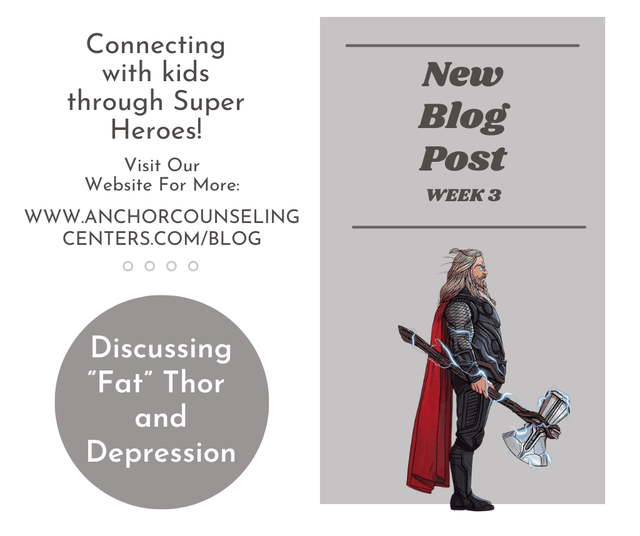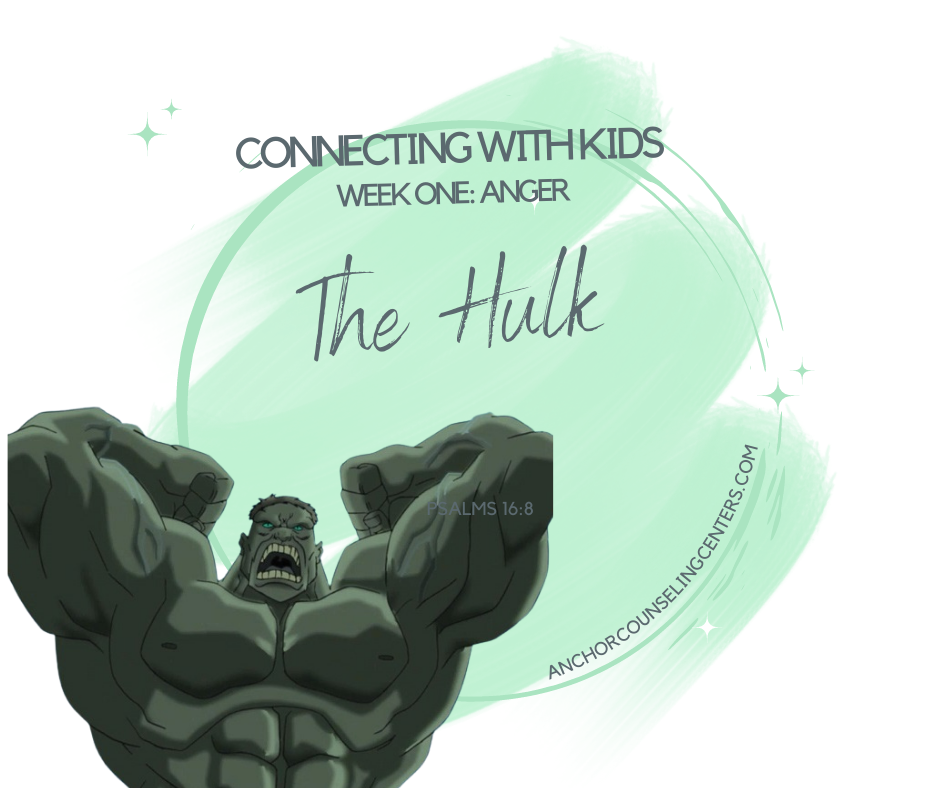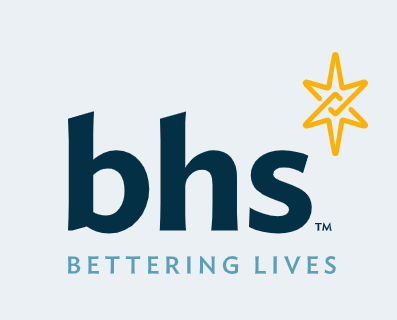|
Depression is an invisible illness that affects people no matter their age, race, or gender. Depression looks different in every person, but symptoms can range from isolation, withdrawal, crying, hopelessness, helplessness, and lack of motivation to poor behavior, lack of interest in activities, and acting out in children.
It is essential for parents to be educated on what depression may look like, and learn to discuss feelings openly and honestly with their children. In today’s blog, we will relate depression to a fan favorite, Thor. “Fat” Thor in Avengers End Game is a classic example of depression. He suffers from debilitating depression after Thanos snapped his fingers and half of the population vanished. Thor would not leave his home, became an alcoholic, gained weight, and did not care about the things that used to bring him joy. As adults, this all makes sense, but your children may not understand how they are feeling. Let’s break it down step by step on how to relate to and discuss depression with your child. 1. Discussing what depression looks like Depression can look different for every child. Sometimes, can be the stereotypical crying, sadness, or loss of interest in activities. Because symptoms of depression in children and adolescents can be more subtle, if parents are not sure what they are looking for, depression can go undetected. Other symptoms include outbursts, reduced ability to function with friends or in social gatherings, or change in appetite. How you can talk to your child: “I can’t believe what happened to Thor after Thanos snapped his fingers and everyone vanished! What did you think when you saw Thor for the first time? Did he look like he was doing well or happy? I wonder what Thor did to get himself out of the sadness he was feeling 2. Defining triggers Depression does not always have triggers, but an increase in depression can coincide with an event or feeling. It is hard to define triggers, but a simple acronym can help with that- AAA (the 3 A’s). Awareness- Noticing how and what you are feeling. This may be a physical reaction or identifying a feeling that is building at the time. Acknowledgment- Understanding and allowing yourself to feel the feeling or pointing out the specific trigger causing the emotional reaction. Action- Removing yourself from a situation or picking a coping skill that can help reduce depression at the moment. How to talk to your child: “I can’t believe how Thor looked/presented when he was feeling sad or down. I sometimes notice that people feel depressed when they are not taking care of themselves- not showering, not brushing their hair, or having puffy eyes from crying. Has there been a time when you do not want to do the things you ‘know’ you have to do? What was that like for you?” **You can also incorporate or explain the 3 A’s in the conversation. 3. Learning coping skills Coping skills come in all shapes and sizes as do symptoms of depression. Depending on what your child is feeling at the time, a coping skill may or may not work. As a therapist, I like to use the Universal Pain Scale and incorporate “if-then” meaning “if I feel ____, then I can do ____. This takes a lot of the pressure off the child and the parents when the child is not sure how they are feeling or what to do. For example, IF you are feeling a 5/10, THEN you can take a time out, take a hot shower, or go on a walk. How to talk to your child: “When Thor’s friends find him sad, depressed, overweight and drinking, they are unsure what to do. If his friends didn’t know how to help Thor, do you think he was able to help himself? It is scary when you feel sad or depressed and does not know what to do- have you felt like that before? I would love to help you make a chart so when you are feeling a certain way, you know what to do and don’t even have to think about it!” 4. How to know when to ask for help Depression can be really scary for your child as well as you. You may feel helpless and not know how to react or what to do. Trying to distract a sad child can be helpful in the short term, but it is important that your child learns skills to battle the depression and continue to live and healthy and positive life. If your child is continuing to withdraw, shows a decrease of interest in activities that once brought joy, is irritable, or appears sad, it may be time to ask for help. How to talk to your child: “It must be hard to feel sad and down when your friends and peers seem to enjoy activities. Thor was sitting in his home, feeling down, and did not make any changes until his friends came to help him. I bet if Thor knew a couple of coping skills, he would have used them and continued to help save the world. Thor did not know what to do when feeling down, but I have a chart we can use so you don’t get stuck or overwhelmed like Thor did. We can add in what you are feeling and coping skills to use when experiencing those feelings.” To wrap up, here is an example of a script to talk to your child: “Have you noticed that Thor seems sad after Thanos snapped his fingers and half of the population vanished? What do you think is going on with him? I am wondering if he is feeling sad because he lost his friends and family, is living alone and making choices that are bad for his health. It is okay to feel sad sometimes, but it can be really hard to feel sad most of the time. Thor felt very sad and we could see a significant change in him. He had poor hygiene, was making unhealthy choices, and did not want to help himself. His friends came to his home to help him get on his feet and become healthy again. Do you have friends or family who can make you feel better? Is there anything that you do to make yourself feel less sad? Thor showered, shaved his beard, and started taking care of himself again (self-care) showing a big improvement in his happiness and health. I am super proud of you for allowing me to help you. It took time for Thor to feel better, but once he started to use his coping skills and make healthy choices, he was back to saving the world with his friends.” I encourage you to comment below or ask questions in the post, I’d love to hear your feedback. If you have a question or topic you think would be a good fit, please feel free to email me at [email protected] or if you are interested in scheduling a therapy appointment, click here.
1 Comment
Grief and loss can be complicated and hard to discuss as adults, but even more difficult for children and adolescents. Sharing stories and memories, honoring the person who passed, or simply talking about it can be very helpful. As for those who do not have the words or the understanding that grief is making them feel a certain way, it can be confusing and scary.
Batman not only lost his parents at a young age, but he witnessed the crime. Batman made it his life's mission to avenge his parents and clear Gotham City of criminals. Batman channeled his sadness and grief into positive actions, but he could have become a criminal himself. We can use Batman’s actions to appropriately discuss grief and loss with our children. Children and adolescents resort to behaviors when feeling overwhelmed and not able to express themselves. We may see a change in the behavior of a child following the loss of a loved one, but not necessarily associate it with the loss. It is important to be prepared to talk about the loss as well as what your child may be feeling. 1. How grief and loss may look in children and adolescents The difficult part when treating grief and loss is that it can look different in each person. As adults, we are able to talk about how we feel, share stories/memories, and process grief over time. Many children and adolescents do not have the words or the understanding to pinpoint grief as a a reason for the big feelings or acting out. The following symptoms may be associated with grief and loss-
How you can talk to your child: “I know it has been a couple of days/weeks since we lost [loved one]. You know, Batman lost his parents at a young age and had a difficult time. He would stay up all night working in the Batcave and keep to himself. Are you having a hard time sleeping, too? Has anything else also been hard? Batman was also irritable and grouchy with Alfred. Have there been times when you have felt grouchy, especially when missing [loved one]?” 2. Noticing behavior changes and how to react As parents, we notice when children or adolescents are acting out, but are not always able to associate a reason or trigger. Grief and loss can take time to feel and gradually impact a child’s mental health. Taking the time to point out changes in behavior without punishing them can open the door to a good discussion about grief and loss. How to talk to your child: “Do you think Batman thinks about his parents often? How do you think Batman feels when he does think about them? I bet he is feeling sad, angry, and hurt. I wonder if other people feel the same thing as him when they think about someone they love and lost.” 3. Learning skills and words to express yourself As Batman makes friends, helps to save the city, and falls in love, he comes out of his home more often and begins to engage in “self-care.” He dresses in suits and attends social functions, which are all positive coping skills. Grief and loss can be complicated and impact many different aspects of life. Our senses can remind us of the person we lost at a time we are not prepared to grieve. This is a time when children and adolescents may act out and we may not connect it to grief. How to talk to your child: “I noticed that Batman still lives in his childhood home, but spends most of the time in his Batcave. I wonder if he is sad living in that big house without his parents. Does Batman look happier when he is around people he loves and that love him? Do you feel happier when you are around other people (or your family)? What else did Batman do to make himself feel better? What have you done in the past to feel happier/less sad?” 4. When it is appropriate to ask for help? While it is normal to feel sad, or not always happy, feelings should appropriately match the situation. Batman was sad due to his grief and loss but was having a difficult time moving forward and grieving. When grief affects Activities of Daily Living (ADLs) such as hygiene, eating appropriately, self-care, or relationships, it is time to seek help. It is better to seek help before ADLs are impacted, but we are happy to see a client at any time during their journey. How to talk to your child: “Do you think it was hard for Batman to get out of bed in the mornings? Do you ever feel like pulling the covers over your head and staying there all day? One way to feel less sad about our loss is to share fun memories of [loved one]. Would you like to tell me a story about you and [loved one]? I would love to hear about some of your memories and I can share one of mine if you would like. Would you like to hear a happy, funny, or loving memory today?” To wrap up, here is an example of a script to talk to your child: “Have you noticed that Batman seems sad or depressed? What do you think is going on with him? I am wondering if he is feeling sad or depressed because he lives alone, doesn’t have too many friends, and lost his parents when he was a child. I bet there are times that you are feeling sad. Sometimes when I see you, you look sad or I see you crying. Is there something that you can think of that is making you sad? When Batman is acting out, he is usually feeling sad. When you are angry, is there something that is also making you sad? I think we can talk about Batman and how he is feeling and relate it to you. When you are alone in your room, you may feel like a “Dark Knight.” When Batman leaves his home and surrounds himself with friends, do you think he is happier or sad? Grief is a combination of emotions such as sadness, anger, guilt, joy, gratitude, anxiety, relief, confusion, and frustration. It is okay to feel any of the emotions, but we get to choose how we act or express them. Batman chooses to use grief as fuel to make Gotham City a safer place for everyone. You can choose to yell, scream, or act out, or we can talk about how you are feeling and why you are feeling that way. Working together can be helpful, just like Batman working with the police to catch criminals. I am super proud of you for allowing me to help you. I know Batman would not be able to catch all of the criminals without the help of Catwoman, Robin, and the police!” I encourage you to comment below or ask questions in the post, I’d love to hear your feedback. If you have a question or topic you think would be a good fit, please feel free to email me at [email protected] or if you are interested in scheduling a therapy appointment, click here. Connecting with kids through Super Heroes!
Week 1 - Using the Hulk to “Smash” Anger Anger is a secondary emotion, meaning that we tend to go towards anger to cover up vulnerable feelings that are not fun to deal with. I have so many patients who are sad, hurt and anxious, but it comes out as anger. Anger is difficult to manage because it takes time to get to the root of the emotion before it can be treated. So how do I help kids with that anger and bring it down to their level, in therapy? Well, we discuss superheroes of course, like our green friend, the Hulk! Everyone loves the massive steam roller when he is working with The Avengers because he uses his powers for good. But when he is unable to control his anger, he ends up laying out Thor, leveling buildings and having the kind of temper tantrums that put insurance companies out of business. Relating anger to a character your child knows and loves, can break down barriers between the two of you. It also allows your child to look inward without feeling scared or embarrassed. While dealing with anger, we do not turn green, but it can be argued that we turn into a creature like the Hulk. The anger children/adolescents feel has a more negative impact on school and at home than the Hulk smashing a city block. So what do we do? How can we teach our children to use that anger for good? For now, it is important to understand that even if your child has some anger issues, that’s not a bad thing. He/she is still your little superhero. We just need to channel that anger a little bit so he/she plans better with the rest of the Avengers! 1. Defining Triggers The Hulk knows exactly what gets him angry- he decided to live in a secluded place before the Black Widow found him and asked him to be an Avenger. While living in isolation is not the best coping skill for anger, the Hulk is aware of his surroundings and triggers. How you can use this to talk to you child: “We know the Hulk is angry, but most of the time he is not green; He is Dr. Banner. What are some of the things that make him angry and how do you know? Do you know of any specific triggers that make you angry and turn into the Hulk?” 2. Learning the physical and emotional changes when angry Other than the obvious physical change where the Hulk turns green, he can feel the other physical changes in his body. He gets hot, sweaty, starts to breathe shallow and rapidly and he is not able to gather his thoughts (racing thoughts). How to talk to your child: “When the Hulk turns green, he is obviously angry. What else happens to him when he is angry? Do you get any of the same feelings? As a parent I can see [fill in the blanks with symptoms]. Do you notice that?” 3. Learning coping skills The Hulk will take an 'adult time out" to cool down, walk away, take deep breaths and will make a joke to relieve tension. These are used BEFORE he becomes green, as coping skills are designed to prevent the anger, not stop it once you are angry. How to talk to your child: “What do you see the Hulk do when he gets angry and doesn't want to smash things? Once he turns green, it is very hard for him to change back into Dr. Banner. When he is Dr. Banner, he tries to use coping skills like deep breathing and walking away. What has worked for you before?” 4. Accepting the anger and using it for good The Hulk accepts that he is an angry man, and we know this because of the quote from the Avengers: Captain America: [Hulk], now might be a good time for you to get angry. It is important to normalize anger with kids, and remind them that anger is a normal reaction. It is important that they learn how to manage the anger appropriately and possibly turn their anger into motivation. How to talk to your child: “You know when he tells the Avengers his secret, that he’s always angry? Why do you think he’s usually Dr. Banner then, and not always the Hulk? Could it be because he has learned to control his anger? To wrap up, here is an example of the “script” my husband would use with his students: “Have you noticed when Dr. Banner turns into the Hulk? Is it a surprise to him, or does he feel it building before he turns green? We can see his anger increasing, which means he can also feel his anger building. Because he is aware of how he feels, he is able to calm himself down to avoid turning into the Hulk. He has learned to manage his anger, and only turns into the Hulk when he is able to to help himself or others. Anger is something that tends to be there all of the time, just waiting to burst out. Can you feel inside when you are having your own “Hulk” moments? This can happen when the anger becomes so intense that you turn into your version of the Hulk? Can you feel the anger building ahead of time? What does it feel like? How do you know when you’re about to turn into the Hulk? The fact that you can now detect that anger building gives you a super power that you can now control! What can you do when you feel that anger building? So now, when you feel the anger building, you can take those steps to avoid turning into the Hulk!” I encourage you to comment below or ask questions in the post, I’d love to hear your feedback. If you have a question or topic you think would be a good fit, please feel free to email me at [email protected] or if you are interested in scheduling a therapy appointment, click here. When you are active and live in a small community, which has been voted America’s Coolest Small Town, everyone tends to know everything about you. That being said, it’s no secret where I live that I am a mental health therapist. I get questions all of the time pertaining to mental health, relationships, challenges at school and general parenting advice.
I’ve decided to create a 6 week series, where I try and answer these questions in a format where everyone can benefit. I would like to use this as a way to give actionable advice to people in the community. I am a firm believer in the importance of connecting with my youth clients. My “business partner” in this is Bodhi, my beautiful yellow lab. Bodhi’s loveable, affectionate manner immediately resonated with my young clients, and make for a great way to break down some of the barriers that those in my professional experience. But what can parents do to break down those barriers? How can patients, who share so many familiar things with their children, connect with them? In this segment, I suggest finding common ground with the use of popular references in Pop Culture. Using Pop Culture to Connect with Your Kids Leigh Thompson is a former Black Belt Instructor at one of the largest Martial Arts Schools in the USA. He has literally taught thousands of people in the community over the last 20 years. I certainly have some familiarity with Leigh and his expertise, as he is also my husband. Leigh had once met a prospective student who was planning to enroll in martial arts. The prospect has planned to enroll himself in the training program in the hopes that martial arts could help him with anger issues. While talking to the prospect, Leigh noticed the young man was wearing a Hulk shirt and immediately recognized the opportunity to connect with him on something he himself knew a lot about. (I love my husband very much, but he is a self-proclaimed comic nerd). The results from this connection were nothing short of fantastic! The student’s parents came in the following week beaming with pride about the positive change that their son had shown. They received letters home from the school saying how the teachers noted a huge improvement in his attitude and behavior. Since applying the strategy, I can tell you the results speak for themselves! |
AuthorWhitney Thompson, LCPC is a Psychotherapist and Owner of Anchor Counseling Centers. ArchivesCategories |
Locations
|
Phone
443-328-4946 Fax 443-539-8173 Suicide & Crisis Line 988 |
Our Mission: ACC is dedicated to promoting positive mental health and wellness through education and high quality mental health counseling to all who seek it.
Our Vision: To provide top quality mental health services and psychological safety for all. |





 RSS Feed
RSS Feed








